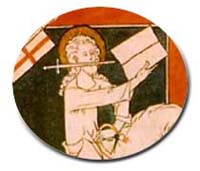Four Ways to Discern a Man's Soul
by His Appearance
You can discern a man's soul by his face, eyes, laugh, clothing and way of walking. These are the ways to know the soul of a man taught by Fr. Cornelius a Lapide, S.J.. If you don't believe it, read these commentaries on the topic by many Saints and Catholic theologians.
Fr. Cornelius a Lapide, S.J.
- The attire of the body and the laughter of the teeth and the gait of the man show what he is. (Ecclesiasticus 19:27)
"Interpreting this verse, Siracides gives four ways by which one can see, as through windows of the soul, the hidden virtues or vices, the simplicity or hypocrisy of a person.
"The first quite clear way is the outward appearance and the expression of the face, principally the eyes. The nature of a person shows and reveals itself by the eyes. For if the lamp of the body is the eyes, why is it surprising if that lamp should reveal the body? So, when one first meets a ferocious man, his eyes seem to spread terror; when one meets a pious man, his eyes spread joy. Just as wisdom and sanctity shine in the face of the wise and the holy, (Eccles, 8:1), so also foolishness and evil darken the face of the stupid and wicked.
"St. Ambrose (Book on Elias, chap. 10) admirably says: “The face is a witness of the thoughts and is a silent interpreter of the heart. The outward appearance is often a sign of the conscience and the unspoken words of the mind.”
"St. Augustine (Rule for the Servants of God, at the end) says: “Do not say that you have pure souls if you have impure eyes, because impure eyes are messengers of an impure heart.”
"The second way is the clothing or dress: overbearing apparel reveals interior pride, false dress reveals falsity; dissolute dress, dissolution; capricious apparel, capriciousness; grave clothing, gravity; sensual dress indicates and represents sensuality of spirit. Hence St. Augustine (Letter 73 to Possidium) says: “The true adornment of the Christian is not false make up, nor opulent and ostentatious dress, but rather good customs.”
"By means of the face, dress, and dissolute customs of Julian the Apostate, St. Gregory Nazianzen discerned his hidden impiety. He refers to it (Speech 2, in Julian) with these words: “Nor does it speak of any good to me to see a man with a weak neck, stooping shoulders, a constantly agitated bearing, insolent eyes and a roving and furious gaze, unstable and tottering feet, an offensive nose breathing contempt, and an arrogant and unrestrained laugh.” After describing his dissolute soul with other similar observations, he argues: “Hence his bearing speaks clearly: What a great evil the Roman land has nourished!” ….
"The third way is the laugh. Indeed, the sincere and regular laugh reveals a sincere, constant and open heart. The short, twisted, sardonic, and arrogant laugh reveals a narrow, twisted, fraudulent, and arrogant spirit and signifies an imbued hatred. In this respect Rabanus says that by the bearing of the body one demonstrates the quality of the will. ….
"The fourth way is the manner of walking. The fast and precipitate way of walking is a symptom of the impulsive spirit, just as the slow step reveals slowness of spirit; the light step, lightness of spirit; the arrogant step, an arrogant spirit; the furious step, an angry spirit; and an affected or feigned step, falseness of spirit.
"For this reason, Bede (in Proverbs) says: “The movement of the body demonstrates the habit of the mind.”
"And St. Bernard (On the Way to Live Well, chap. 9) says: “Let your way of walking be simple, and your step honest. No shame, no sensuality, no arrogance, no insolence, no frivolity should appear in your way of walking. Indeed, the spirit shows itself in the movement of the body, the carriage of the body is a signal of the soul.”
(Commentaria in Scripturam Sacram, Paris 1875, vol. 9, pp. 542-542)

Posted January 10, 2006

|